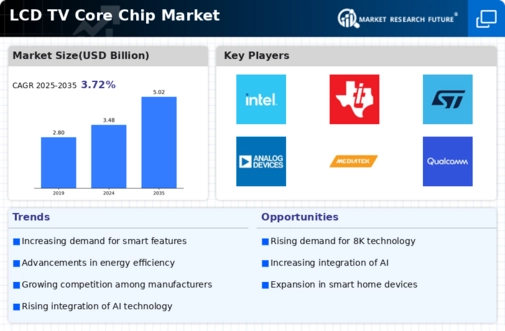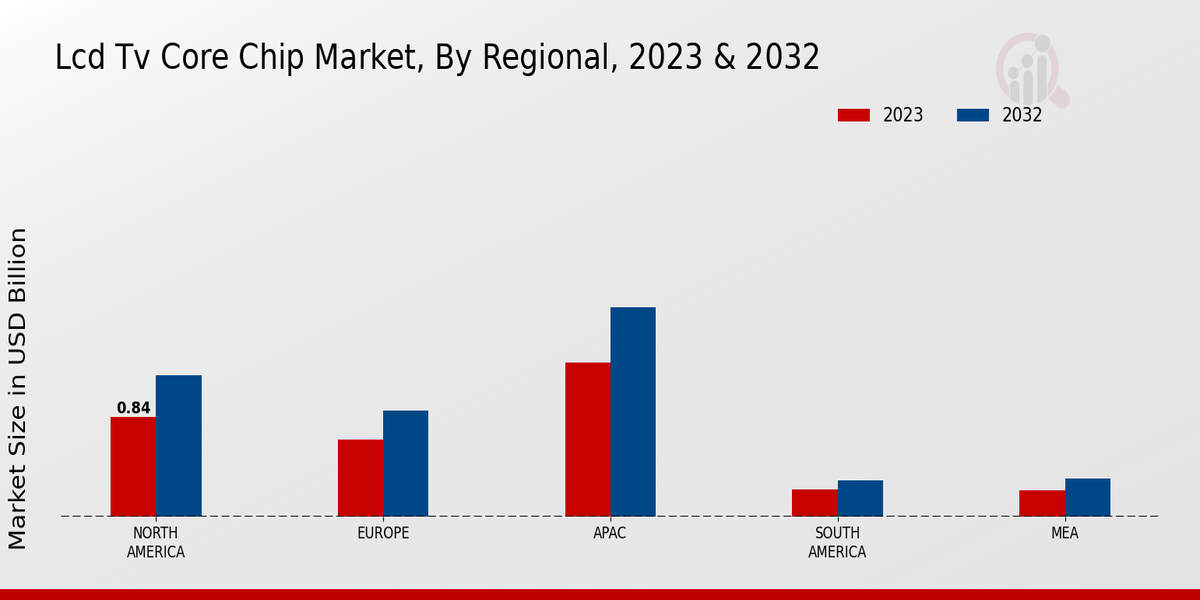Market Growth Projections
The Global LCD TV Core Chip Market Industry is poised for substantial growth, with projections indicating a market value of 3.48 USD Billion in 2024 and an anticipated increase to 5.02 USD Billion by 2035. This growth trajectory is supported by a compound annual growth rate (CAGR) of 3.39% from 2025 to 2035. These figures suggest a robust demand for advanced core chips, driven by technological advancements and changing consumer preferences. The market's expansion reflects the ongoing evolution of the television industry, as manufacturers strive to meet the increasing expectations of consumers for enhanced viewing experiences.
Growing Adoption of Smart TVs
The growing adoption of smart TVs is a pivotal driver for the Global LCD TV Core Chip Market Industry. As consumers increasingly seek integrated features such as streaming services, internet connectivity, and smart home compatibility, the demand for sophisticated core chips rises. This trend is evidenced by the anticipated compound annual growth rate (CAGR) of 3.39% from 2025 to 2035, reflecting a sustained interest in smart technology. Manufacturers are focusing on developing chips that support advanced applications and user interfaces, thereby enhancing the overall viewing experience. This shift towards smart TVs is likely to shape the future landscape of the industry.
Expansion of Content Streaming Services
The expansion of content streaming services is reshaping the Global LCD TV Core Chip Market Industry. With platforms like Netflix, Hulu, and Amazon Prime Video gaining popularity, consumers are increasingly investing in LCD TVs that can seamlessly support these services. This trend necessitates the development of core chips capable of handling high-bandwidth applications and delivering smooth streaming experiences. As the market evolves, manufacturers are likely to prioritize chip designs that enhance connectivity and processing capabilities, ensuring compatibility with a wide range of streaming services. This growing demand for streaming-ready devices is expected to contribute to the industry's growth.
Technological Advancements in Chip Design
Technological advancements in chip design are significantly influencing the Global LCD TV Core Chip Market Industry. Innovations such as System on Chip (SoC) architectures enable manufacturers to integrate multiple functionalities into a single chip, enhancing performance while reducing costs. This trend is particularly relevant as the industry anticipates a market value increase to 5.02 USD Billion by 2035. Enhanced processing power and energy efficiency are critical for meeting the evolving demands of consumers. As manufacturers adopt these advanced designs, they are likely to gain a competitive edge, further driving growth in the market.
Rising Demand for High-Definition Displays
The Global LCD TV Core Chip Market Industry is experiencing a surge in demand for high-definition displays, driven by consumer preferences for superior viewing experiences. As households increasingly adopt larger screen sizes, the need for advanced core chips that support higher resolutions becomes paramount. This trend is reflected in the projected market value of 3.48 USD Billion in 2024, indicating a robust growth trajectory. Manufacturers are compelled to innovate, integrating features such as enhanced color accuracy and faster refresh rates, which are essential for modern entertainment systems. This demand for high-definition capabilities is likely to propel the industry forward.
Emerging Markets and Increased Consumer Spending
Emerging markets are playing a crucial role in the Global LCD TV Core Chip Market Industry, as increased consumer spending drives demand for affordable yet high-quality television options. Countries in Asia-Pacific and Latin America are witnessing a rise in disposable incomes, leading to greater investments in home entertainment systems. This trend is expected to bolster the market, with manufacturers focusing on producing cost-effective core chips that do not compromise on performance. As these regions continue to develop economically, the demand for LCD TVs equipped with advanced core chips is likely to rise, further fueling industry growth.























Leave a Comment